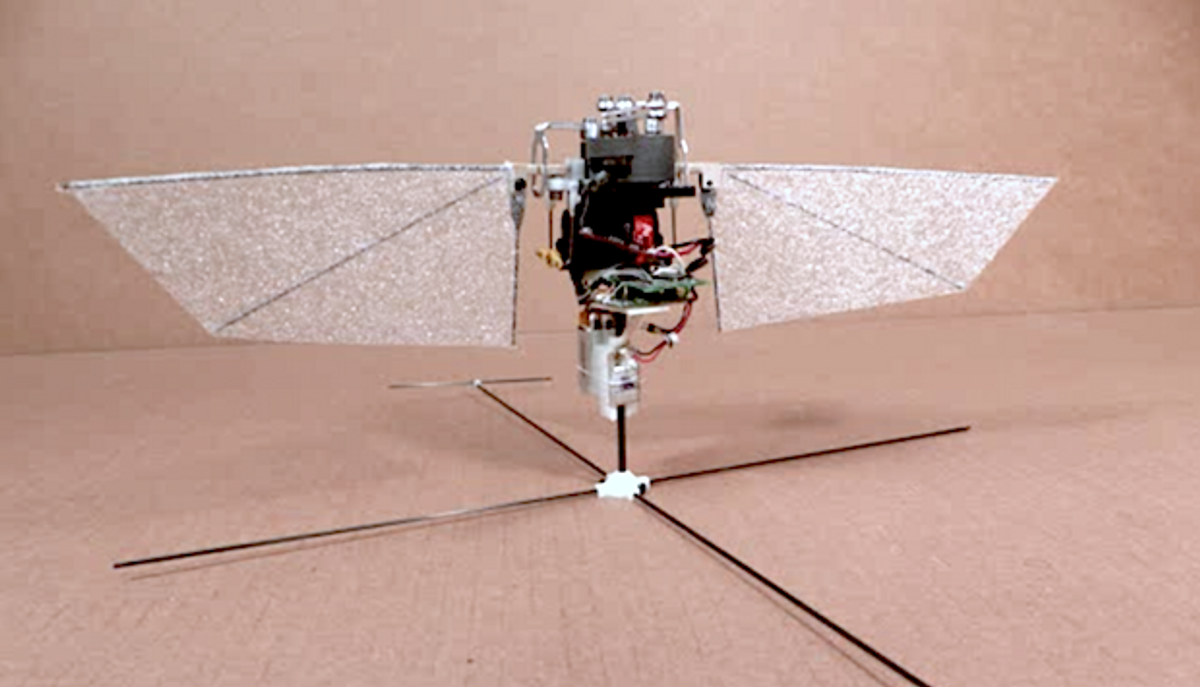We spent most of this week out in Las Vegas checking out Daimler’s new Freightliner autonomous truck. If you haven’t seen it yet (and if you’re not following our Cars That Think blog), click here: it’s very cool. The rest of the week’s robotics news may pale (ever so slightly) in comparison with an event that included a light show projected onto the Hoover Dam, but that doesn’t mean that we don’t have our usual messy heap of Friday robot videos for you.
A robot…desk? It’s actually not a bad idea, and it’s on Kickstarter:
This is a project from the guys at RobotBase, and it’s already funded on Kickstarter. The fully autonomous version of the desk is US $600, which is a lot, and we’re a bit skeptical about all of the voice-activated “personal assistant” features promised in the video, but the desk is shipping in July, so we’ll find out soon if they can deliver.
[ Kickstarter ]
A few years ago, we covered a cyclocopter under development by Professor Moble Benedict. More recently, Benedict’s Advanced Vertical Flight Lab at Texas A&M has been working on a very impressive robotic hummingbird, led by grad student David Coleman:
If this reminds you of something, it’s almost certainly AeroVironment’s robot hummingbird from a few years back:
The difference? Well, for one thing, AeroVironment’s robot was funded by DARPA, and since we haven’t heard anything about it for a couple years, we’re assuming that it’s been lost to some kind of super secret military application or something. This new one is a research robot, and as such, we might have a chance of following its development and seeing it learn how to do new stuff.
[ AVF Lab ]
Thanks Moble!
While the Ebola crisis might be on the wane (though you never know where the virus can lurk), that doesn’t mean that we shouldn’t be preparing for the next crisis, since not being prepared in the first place was one of the things that made Ebola so dangerous. It’s not easy to integrate robots into existing healthcare workflows, especially in the developing world, but the first step is to get a system that both works and can make a tangible difference. At Oregon State University’s Ebola Treatment Unit, they’re working with a Baxter robot that can be teleoperated to manipulate common medical objects:
Last we checked, all Baxters running the most up to date software version are immune to Ebola.
[ OSU ]
Mech Warfare, which apparently didn’t make it to RoboGames this year, is alive and firing in Tucson:
[ RTEAM Robotics ] via [ Trossen ]
Looks like this robot had too much WD-40 or whatever it is that robots drink:
Come to think of it, the belay would be an excellent idea for stumbling people, too.
[ UT HCRL ]
The nice thing about robots is that if have the right infrastructure in place, when one of them learns how to do something, you can just transfer that knowledge to a totally different robot. Like, how to grasp things:
Just imagine if humans could do that. Sigh. We’re doomed, aren’t we?
[ iCub ]
The Intelligent Robots and Systems group is a research group in Institute for Systems and Robotics, Instituto Superior Técnico, University of Lisbon (Portugal). This video shows a collection of some of our recent research work involving robots.
And it does so very, very quietly:
[ IRS Group ]
Instead of trying to set up a drone to safely fly close to objects, an easier approach is to not worry about getting close to anything and instead just use a 30x optical zoom camera to make everything look close:
This multi-mission payload combines the capabilities to record and live-stream data with a smooth, stable video capability in any weather condition. It is capable of 10 megapixel still images, and onboard vision processing technology which provides a click-to-track functionality. When conducting surveillance or inspection missions, the payload reduces the workload of the operator with advanced autonomy. It also has a built in laser illuminator that allows users with night vision goggles to see targets for military missions, such as search and rescue
Here’s what Adept was demonstrating at Automate 2015.
I’m not much of a sports guy, but I don’t think that’s how basketball is supposed to work…?
[ Adept ]
In Richfield Springs, N.Y., NAO robots are being used to teach sixth graders math (as well as programming for high school students) and it looks like fun:
[ Aldebaran ]
For slightly older kids at community colleges, NASA held a Lego rover design competition, which looks like even more fun:
[ NCAS ]
Here’s what the Chiara Mantis robot looked like as of late last year: it walks!
[ CMU ]
We’re familiar with TORC Robotics from the DARPA Robotics Challenge (they’re part of Team VIGIR), but they also do a lot of work on autonomous ground systems, like these:
[ TORC Robotics ]
A safety parachute for your quadrotor doesn’t get much smarter than this, because it doesn’t require you to do anything. It just works.
Note that the final version of this system will be 30 percent smaller than what’s in the video. And $130 each seems a bit expensive, but how much did you pay for your fancy new drone that you’re almost certainly going to eventually crash?
[ Kickstarter ] via [ DIYDrones ]
SRI International’s Taurus system, developed for military and domestic bomb squads, addresses challenges presented when inerting explosive devices and removing hazardous materials.
[ SRI ]
TechUnited Eindhoven won the 2015 RoboCup@Home competition; here are some videos of their robots in the finals:
[ TechUnited ]
Our ending video this week is a talk from Professor Riaan Stopforth on “Research in the fields of Search and Rescue Robotics and Bio-Mechatronics.”
Via [ NCCR ]
Evan Ackerman is a senior editor at IEEE Spectrum. Since 2007, he has written over 6,000 articles on robotics and technology. He has a degree in Martian geology and is excellent at playing bagpipes.



